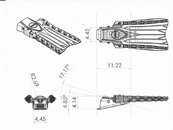@tursiops you made an excellent work with the available experimental data.
What follows is not based on such large set of experiments, so please, take it with a grain of salt.
Also consider my background: on one side I have a PhD in Applied Physics, and I did teach thermo fluid dynamics in postgraduate engineering courses for 15 years.
On the other side, I am a finned swimming instructor and I used to train athlets in that sport.
Using fins for propulsion is the most efficient self-propulsion technique for an human in water.
Propulsion means producing a thrust which moves the body in the opposite direction. But in some cases the thrust is not causing motion, it can be used for remaining buoyant whilst overweighted, for example. So the thrust not necessarily converts to power (power is the product of force×speed - if there is no speed, power is zero).
The performances of such a propulsion technique can be evaluated in three ways:
- thrust produced
- speed obtained
- efficiency
Let's focus in this post on the latter. How we define efficiency?
The most commonly accepted definition is energetical efficiency: the ratio between the output power over the consummed power.
We know that the output power is given by thrust×speed. At constant speed, thrust must be equal to the drag force, which depends mostly on the hydrodynamic of the human body. Which means the cross-section area A and the Cx, both multiplied by the square of speed.
So we have this expression for the power produced:
Wout = 1/2×rho×A×Cx×v^3
Changing fins usually affects only speed v, all other factors are substantially unchanged.
The consummed power is the energy burned by the muscles involved in the kicking action in one second.
This is reasonably well correlated with oxygen consumption, which can be measured.
So the correct way of estimating efficiency is to compute the ratio beteeen these two powers.
One simple way to simplify the problem is to fix the speed v, making Wout constant, and measuring Win by measuring oxygen consumption.
This however is somewhat biased, as swimmers of different muscolar capability could produce much larger Win, and so they could drive longer, stiffer fins.
On the other side, larger athlets produce more power, but have larger ceoss-section and often cannot get the same good Cx as leaner athlets (or females)
Also the leg geometry affects performances, as this changes the angle of attack and the trajectory of fins while kicking.
So the data you processed, albeit looking "objective", are in reality entirely biased.
The whole approach of ginding "the more efficient fin" is wrong.
The correct approach is the following:
Here I have an athlet with a given mass, cross-section area, leg geometry and muscular capability. What is the fin allowing him to get the best performances?
I mean one of these three targets:
- the maximum thrust for a given time
- the maximum speed over a given distance
- the maximum efficiency, allowing him to swim longer with a single breath.
The answers in general are three very different fins.
Of course monofins are superior, but let stay with two separate fins.
Regarding the third goal (efficiency) for most athlets with proper training and years of practice the optimal fins are very elastic (carbon fiber), long and flexible, and have little, zero or even positive slope.
The exact values of stiffness, length and blade angle must be carefully tuned for each athlet, and could change based on the distance to cover and for vertical or horizontal underwater swimming, or for surface swimming (the latter usually asking for a significantly positive blade angle).
Evaluating the performance is simple when working on a single athlet: you repeat several times the same test, measuring speed or distance traveled, and following the feedback from the athlet. At the time I was usually able to define and build the optimal fin(s) with a dozen attempts.
Please note that each attempt can cost between 200 and 1000 USD.
The best, more experienced finned swimming instructors claim to define the optimal fin(s) with just 5-6 attempts.
So in conclusion the search for a single "best" fin is wrong.
Free divers and finned swimming athlets under continuous training can make a very good use of their personally-tuned, expensive fiber carbon fins.
For occasional divers or novices, much shorter and more flexible fins, with a negative blade angle, are preferable, avoiding cramps and over-exertion. They are of course less efficient, but efficiency is of no value when your legs are blocked by cramps, or your lungs and heart cannot provide all the oxygen burned by your muscles.





